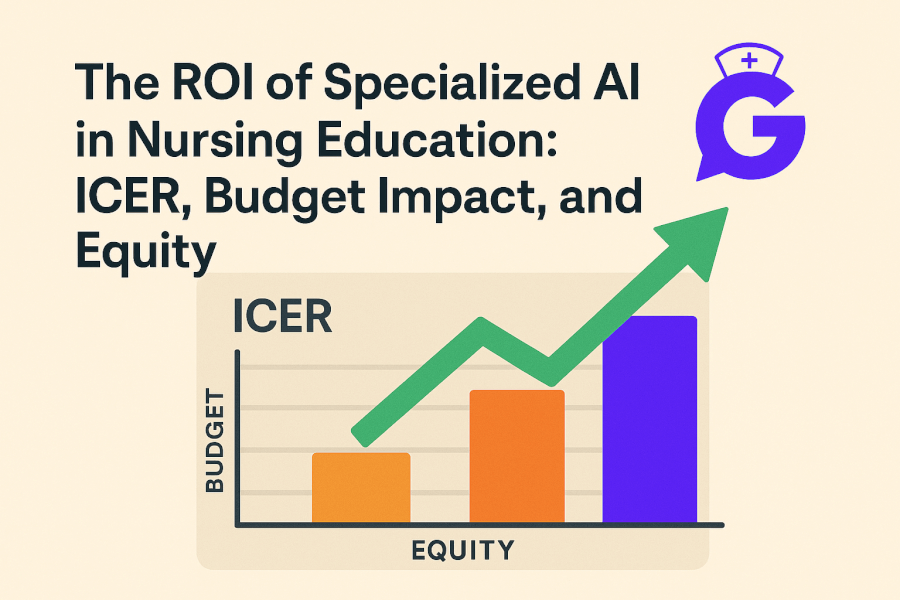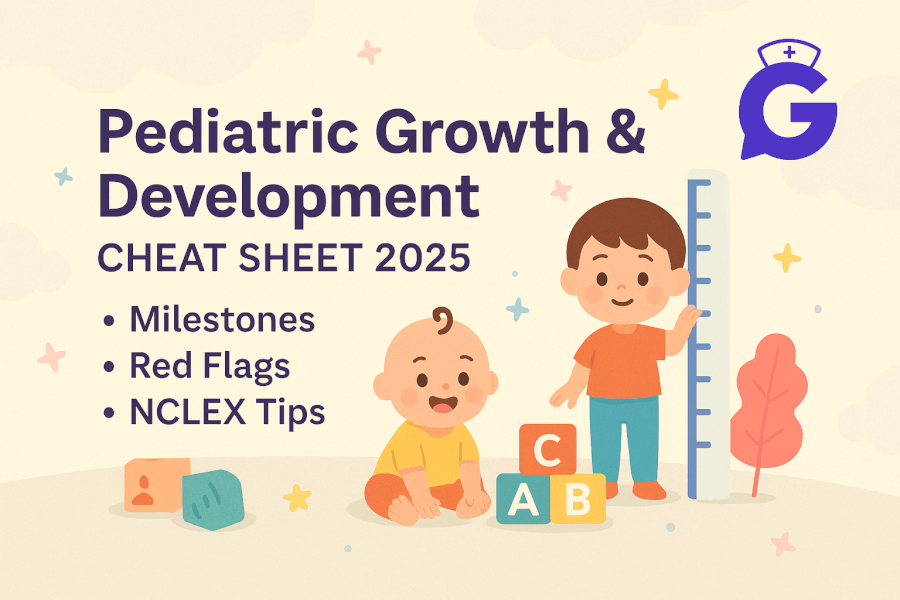Purpose: Help deans, curriculum committees, and faculty quantify the return on investment (ROI) of adopting a specialized AI tutor across nursing courses - using University of Rochester study results and a practical cost-effectiveness (ICER) framework.
TL;DR key takeaways
- University of Rochester research found GoodNurse users averaged 95.1% vs 88.8% for non-users (p = .0048).
- A separate model comparison reported highest overall accuracy for GoodNurse on an 88-item exam and best accuracy per dollar among tested models.
- Using the studies’ cost assumptions, the incremental cost-effectiveness ratio (ICER) was ≈ $5.80 per 1% grade improvement.
- Programs of 30, 120, and 300 students can show positive budget impact when improvements reduce repeats and remediation time.
- Pricing note: our consumer price is $9.99/student/month (B2C). Enterprise/semester pricing is not finalized; examples below show $9.99 × 3–4 months per semester as a placeholder and may change over time.
- Background: see our companion piece, Independent University Research: GoodNurse Improves Outcomes and Learning Efficiency in Nursing Education.
🎯 Free NCLEX quiz!
Test your knowledge - new quizzes added weekly!
1) What ICER means for nursing programs
ICER (Incremental Cost-Effectiveness Ratio) answers: How many dollars did we spend for one additional unit of outcome? ICER = (Cost_with_AI − Cost_without_AI) ÷ (Outcome_with_AI − Outcome_without_AI)
Outcomes can be:
- Average course grade (percentage points).
- % correct on a standardized exam
- Progression/retention or repeat-course rates.
Why faculty like ICER: transparent, easy to recompute locally, and comparable to alternatives (extra lab hours, tutoring modules). For background, see CDC program evaluation and ICER basics (.gov) and NIH/NCBI overviews (.gov/.nih).
2) Using Rochester findings as your starting values
Standout result (for committee slides): “GoodNurse users averaged 95.1% vs 88.8% for non-users.” - University of Rochester School of Nursing (ENRS 2026 abstracts)
Evidence snapshot
- Course performance: 95.1% (users) vs 88.8% (non-users), p = .0048.
- Cost-effectiveness: Semester ICER ≈ $5.80 per 1% grade gain per student.
- Model comparison: GoodNurse led overall accuracy on an 88-item exam and was most cost-effective among models tested.
Quick local ICER example: If your local lift is +5 points, ICER ≈ 5 × $5.80 = $29 per student for the gain (using the abstract’s cost basis). Departments can contrast that with the cost of extra lab hours, remediation, or private tutoring.
Integrity context: NCLEX explicitly restricts electronic devices at the test center; use AI for learning/practice, not graded assessments (see NCSBN and NCLEX links below).
3) Budget impact scenarios
Pricing disclaimer: Examples use $9.99 × 3 or 4 months to approximate a semester. Enterprise pricing is not finalized and may change over time. Other assumptions: average lift +5.0 points; avoided repeats 2–4%; faculty time saved 0.5–1.0 hr/student (triage to targeted practice); institutional cost per repeat $400 placeholder; faculty time $60/hr placeholder.
A) 30-student pilot section
| Line item | 3 months (29.97 ea) | 4 months (39.96 ea) | Notes |
|---|---|---|---|
| Semester access cost | $899.10 | $1,198.80 | 30 × monthly × months |
| Avoided repeats (2% → 0%) | $240 saved | $240 saved | 0.6 student × $400 |
| Faculty time saved (0.5 hr × 30 × $60/hr) | $900 saved | $900 saved | Local rate |
| Net budget impact | +$240.90 | −$58.80 | Savings − Cost |
Many pilots still proceed at small net cost if outcomes and equity improve. Increasing avoided repeats to 3–4% or time saved to 1 hr/student typically makes pilots net positive even at 4 months.
B) 120-student, multi-section course
| Line item | 3 months | 4 months | Notes |
|---|---|---|---|
| Semester access cost | $3,596.40 | $4,795.20 | 120 × monthly × months |
| Avoided repeats (3% → 0.5%) | $1,000 saved | $1,000 saved | ~3 students × $400 (rounded) |
| Faculty time saved (0.75 hr × 120 × $60/hr) | $5,400 saved | $5,400 saved | |
| Net budget impact | +$2,803.60 | +$1,604.80 | Savings − Cost |
C) 300-student pre-licensure cohort
| Line item | 3 months | 4 months | Notes |
|---|---|---|---|
| Semester access cost | $8,991.00 | $11,988.00 | 300 × monthly × months |
| Avoided repeats (4% → 1%) | $3,600 saved | $3,600 saved | 9 × $400 |
| Faculty time saved (1 hr × 300 × $60/hr) | $18,000 saved | $18,000 saved | |
| Net budget impact | +$12,609.00 | +$9,612.00 | Savings − Cost |
Swap in your local repeat-course cost, faculty rates, and observed lift. The ICER is independent of cohort size and remains your apples-to-apples yardstick.
4) Equity guardrails: who benefits, and by how much?
Track outcomes by:
- Baseline GPA bands (e.g., ≤3.0 vs >3.0).
- First-time vs repeaters.
- Course format (in-person, hybrid, evening).
- Clinical placement (telemetry, med-surg).
Equity dashboard checklist
- Target lift: ≥3–5 points across lower GPA bands.
- NGN performance: improved matrix/grid and bow-tie accuracy.
- Early alert: flag low time-on-task by week 2 for outreach.
- Accessibility: alt-text, keyboard navigation, sufficient color contrast for practice materials.
5) Integrity & compliance (NCLEX-aligned)
- Allowed: AI for study, practice, and debrief.
- Not allowed: AI on graded assessments unless explicitly permitted and proctored.
- NCLEX: Electronic devices prohibited at the test center; candidates must demonstrate independent competence. See NCSBN and NCLEX policies below.
Further Reading (GoodNurse ecosystem)
- Independent University Research: GoodNurse Improves Outcomes and Learning Efficiency in Nursing Education — https://goodnurse.com/article/239/independent-university-research-goodnurse-improves-outcomes-and-learning-efficiency-in-nursing-education
- AI Prompt Library for Nursing Students (2025) — https://goodnurse.com/article/199/ai-prompt-library-for-nursing-students-2025-care-plans-pharmacology-ngn-study-notes
- Best AI Apps for Nursing Students (Comparison) — https://goodnurse.com/article/134/best-ai-apps-for-nursing-students-2025-honest-comparison-for-classes-nclex
- NGN Prioritization, Delegation & Assignment (Safety-First) — https://goodnurse.com/article/216/nclex-prioritization-delegation-assignment-2025-safety-first-framework
- ABG Interpretation: 15 Practice Cases — https://goodnurse.com/article/201/abg-interpretation-made-simple-2025-15-practice-cases-with-answers-nursing-rationale
References (.edu/.gov/.org)
- University of Rochester School of Nursing — program & research hub: https://son.rochester.edu/
- Eastern Nursing Research Society (ENRS) — conference info: https://www.enrs-go.org/
- NCSBN — NCLEX policies & candidate rules: https://www.ncsbn.org/ and https://www.nclex.com/
- CDC — Program evaluation & cost-effectiveness (ICER): https://www.cdc.gov/evaluation/index.htm
- NIH/NCBI Bookshelf — Clinical skills & learning resources: https://www.ncbi.nlm.nih.gov/books/







